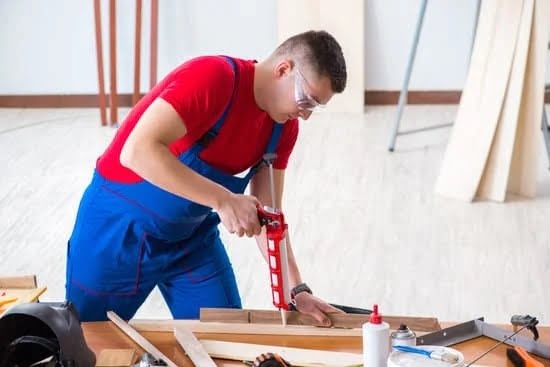Introduction
More and more students are looking to small woodworking projects as an outlet for creativity and expression. Woodworking projects provide an engaging way to explore technology, design concepts, problem-solving, craftsmanship, and manual dexterity. Being able to create something tangible that can be shared and admired is also a great sense of accomplishment and can fuel a lifelong interest in woodcraft.
Small projects that require basic tools such as a saw, drill, and hammer are perfect for beginners getting started with woodworking. These projects give students the opportunity to learn about proper measurements, angles, cutting techniques approaches, clamping principles, sanding processes and more – all while crafting something functional or aesthetically pleasing. Ideas such as making a small birdhouse or garden toolbox offer big rewards in terms of knowledge gained while being well within the skill set of most newcomers.
Once the basics of woodworking have been mastered by completing smaller projects students may wish to move onto larger scale pieces such as desks or chairs. With additional time invested in learning more advanced building techniques through larger scale builds comes vast potential for enhancing student’s confidence for tackling complex projects in the future. Finishing these bigger pieces allows for greater creative freedom with stain colors or different types of varnishes and sealants for protecting against wear and tear over time. Woodworking also provides a great avenue for self-expression with simple touches like engravings or carvings lending itself nicely to personalizing almost any item from boxes to picture frames
Types of Woodworking Projects
Small woodworking projects for students can range from relatively easy to rather complex, as skill levels and desires of the student vary. For beginners, simple projects such as birdhouses, benches and cabinets may be ideal to start with. The simpler small woodworking projects focus on basic carpentry and joinery techniques, allowing students to familiarize themselves with the basics of woodworking without overwhelming them. More advanced projects could include furniture pieces and more complex structures such as puzzle boxes or multi-layered designs. Regardless of the type and complexity of the project, safety is always paramount. Students should make good use of basic safety and research the correct use of power tools before they start any project. Additionally, they should becoming familiar with building plans and diagrams before starting a project in order to ensure that their outcomes are desirable and successful. Working on a variety of smaller scale project will allow students to gain confidence in their skillsets while developing methods which will help them tackle bigger and more ambitious production tasks in due time.
Recommended Materials
When it comes to small woodworking projects for students, the most important part is having the correct tools and materials. Depending on the project, there are certain materials that you will need to complete it successfully. Here is a list of commonly used materials for small woodworking projects with guidance for where to acquire them:
Wood – Wood can be purchased in pre-cut sizes from craft or hardware stores if somewhat specific shapes are needed; otherwise lumber yards typically provide thicker planks available in long lengths that can be cut as needed.
Glue – Glue is often sold by volume (ounces or litres). Your local hardware store will have various types and brands.
Filler – Filler comes in several forms and densities which should be matched to the intended use. Look for auto body filler, wood-based putties, drywall adhesives, or epoxy mixtures in your local auto parts store, home centre, or hobby shop.
Paint – There are a number of paints available for just about any kind of project ranging from water-based acrylics to oil-based enamels. Depending on the type of finish you desire, look for these combinations at home centres and hobby stores alike.
Sandpaper – Sandpaper ranges from very coarse (used for taking off paint) to very fine grades (used for polishing). Generally this item is found at home centres, specialty shops, and online vendors.
Finishes – Finishes such as varnish, shellac, waxes, and lacquer can be used alone or in combination depending on desired results. Finishing supplies can also be found at most home centres or specialty finishing shops near you.
Examples of Small Woodworking Projects
1. Bird house – A great project for students who are just starting to learn woodworking. Using simple tools, students can construct a basic birdhouse frame from a pre-cut piece of wood they are able to hold and manipulate with ease. They could then decorate their birdhouses using non-toxic paint or markers.
2. Cutting board – This type of project builds skills in planning out cuts, making precise measurements and creating the final product safely. Students can start by learning how to design their cutting boards with measurements that match the supplies they have available, before being ready to use saws, measuring devices and sandpaper to shape and finish their creation.
3. End table – For slightly more advanced students, building an end table encourages creative thought as they plan out proportions and depths for bottom shelves, middle layers and top boards of the table’s frame. It is also possible for them to add options such as gluing and dowel joinery for tighter fits between pieces of wood, allowing them the opportunity to understand and implement those techniques into their designs.
4. Bookcase – Another more complex project offered is the ability for students to design a customized bookcase from scratch. Planning what materials are needed beforehand allows students ample room to try different kinds of joints such as corner braces or both drawbore & biscuits joinery methods for added authenticity and strength on the bookcase’s frame. After it has been built, additional details such as staining or painting can be done safely too!
Safety Precautions
Having safety guidelines in place is essential when students are undertaking small woodworking projects. It is important to discuss the dangers of working with tools and helpers with students before beginning any project. It’s essential that students wear protective goggles, gloves, aprons, hearing protection and a respirator rated for dust inhalation when using power tools. A good rule to follow for setting up an appropriate workspace is to ensure all machines are correctly grounded. Additionally, make sure all blades of saws and drills are clean and sharp and inspect them before use. Any machine used should also be adjusted according to manufacturer’s instructions and the particular type of material being worked on.
When it comes to moving wood around or carrying heavier materials or tools, two or more people should assist each other as a safety measure—no one should place themselves at risk by trying to lift heavy objects alone. As an extra precautionary measure, conducting regular inspections of electrical systems found in the school is recommended; regularly check cords for fraying or exposed wiring. Be aware of any clutter that can cause tripping hazards in the work area always keep floors free of materials and tools until they can be put away properly stored away in suitable means such as a shelve or cupboard with doors which are closed securely once put away. Finally, have an emergency plan ready in case severe injury occurs while students are engaged with their projects—take time beforehand to explain where help can found quickly and safely if things go wrong!
Step-By-Step Instructions
Small woodworking projects are great for students who are just starting to learn the basics of carpentry. They provide a fun and exciting way to learn the essential steps and techniques required to become a skilled carpenter. By working on small projects, you can focus on each step without becoming overwhelmed. Here are some tips for successful small woodworking projects that students should follow:
1. Safety: Always wear safety goggles when using power tools, keep your work area clean and well lit, and be mindful of what is happening around you at all times.
2. Plan ahead: Before starting your project, carefully plan out your design by making detailed sketches and measurements of the pieces involved.
3. Choose the right tools: Each type of woodworking project requires different types of tools; make sure to use the most appropriate tool for each job.
4. Take your time: Rushing through a woodworking project can lead to subpar results or even injury; take your time and pay attention to detail for optimal results.
5. Be patient: If a piece doesn’t fit perfectly or something goes wrong, don’t give up! Work through the challenge until you find a solution that works best for you.
6. Review what not to do: Read up on common mistakes made while constructing small woodworking projects so you can avoid making them yourself!
Finishing Up
One of the ways to bring out the beauty and luster of a small woodworking project is with the right finishing option. Finishing a woodworking project can protect it from immediate damage while also enhancing its overall appearance. Woodworkers can explore finishing options such as staining, varnish, and polyurethane, to name a few. Each has desirable characteristics that give them different purposes and appearances.
Stains are used to impart deeper color into the wood, often emphasizing its existing grains. They can range from light tints all the way up to dark tones, and they come in both water-based and solvent-based varieties. Varnish provides greater durability since it forms a strong, protective film over the wood’s surface; however it may alter the texture of the grain or lighten some of its original colors, so when staining it’s important to use pre-tinted varnishes instead of clear. Polyurethane is another popular finish due to its excellent adhesion; however, it must be applied multiple times on top of sanded surfaces for maximum effectiveness. Additionally, lacquer is useful for glossy projects since its fast drying capabilities create a hard wearing and very resilient film with superior clarity over time.
It is important for students learning about small woodworking projects to understand how the various finishes work and how they might change their finished product. With so many finishing options available they will have many unique choices depending on what effect they ultimately want their project to have. Using these various finishes in combination could be an interesting way of exploring different outcomes as well!
Conclusion
Small woodworking projects can provide students with a wealth of learning experiences and amazing results. The tangible process of creating something with wood builds problem solving skills, develops motor coordination, instills pride in a job well done, encourages patience and creativity, and provides a sense of accomplishment. Woodworking also imparts an appreciation for quality craftsmanship and the science of what makes things work. Working on small projects introduces children to a type of hobby that requires planning, resourcefulness, and dedication to see it through till the end. With the right materials and guidance, young people often have great success in building their own creations from scratch. As students build more projects and increase their level of difficulty over time, they gain valuable experience that can serve them for many years to come. We therefore encourage further exploration into this wonderful world of woodworking; what you learn today may prepare you for new challenges in life into the future!

Hi everyone! I’m a woodworker and blogger, and this is my woodworking blog. In my blog, I share tips and tricks for woodworkers of all skill levels, as well as project ideas that you can try yourself.





